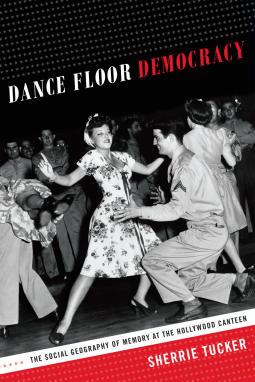Please wait... This may take a moment.
Dance Floor Democracy
The Social Geography of Memory at the Hollywood Canteen
This title was previously available on NetGalley and is now archived.
Pub Date
Oct 17 2014
| Archive Date
Oct 17 2014
Description
Open from 1942 until 1945, the Hollywood Canteen was the most famous of the patriotic home front nightclubs where civilian hostesses jitterbugged with enlisted men of the Allied Nations. Since the opening night, when the crowds were so thick that Bette Davis had to enter through the bathroom window to give her welcome speech, the storied dance floor where movie stars danced with soldiers has been the subject of much U.S. nostalgia about the "Greatest Generation." Drawing from oral histories with civilian volunteers and military guests who danced at the wartime nightclub, Sherrie Tucker explores how jitterbugging swing culture has come to represent the war in U.S. national memory. Yet her interviewees' varied experiences and recollections belie the possibility of any singular historical narrative. Some recall racism, sexism, and inequality on the nightclub's dance floor and in Los Angeles neighborhoods, dynamics at odds with the U.S. democratic, egalitarian ideals associated with the Hollywood Canteen and the "Good War" in popular culture narratives. For Tucker, swing dancing's torque—bodies sharing weight, velocity, and turning power without guaranteed outcomes—is an apt metaphor for the jostling narratives, different perspectives, unsteady memories, and quotidian acts that comprise social history.
Open from 1942 until 1945, the Hollywood Canteen was the most famous of the patriotic home front nightclubs where civilian hostesses jitterbugged with enlisted men of the Allied Nations. Since the...
Description
Open from 1942 until 1945, the Hollywood Canteen was the most famous of the patriotic home front nightclubs where civilian hostesses jitterbugged with enlisted men of the Allied Nations. Since the opening night, when the crowds were so thick that Bette Davis had to enter through the bathroom window to give her welcome speech, the storied dance floor where movie stars danced with soldiers has been the subject of much U.S. nostalgia about the "Greatest Generation." Drawing from oral histories with civilian volunteers and military guests who danced at the wartime nightclub, Sherrie Tucker explores how jitterbugging swing culture has come to represent the war in U.S. national memory. Yet her interviewees' varied experiences and recollections belie the possibility of any singular historical narrative. Some recall racism, sexism, and inequality on the nightclub's dance floor and in Los Angeles neighborhoods, dynamics at odds with the U.S. democratic, egalitarian ideals associated with the Hollywood Canteen and the "Good War" in popular culture narratives. For Tucker, swing dancing's torque—bodies sharing weight, velocity, and turning power without guaranteed outcomes—is an apt metaphor for the jostling narratives, different perspectives, unsteady memories, and quotidian acts that comprise social history.
Advance Praise
"The publication of Dance Floor Democracy elevates cultural studies scholarship to new levels of sophistication and significance. Sherrie Tucker's impressive skills as an oral historian, musicologist, and gender studies specialist coupled with her focused attention on the particularities of place and time have enabled her to craft an exemplary book. A book that is at one and the same time, a social history of the U.S. home front during World War II, a magnificent demonstration of how commercial culture functions as a historical force, and a generative exploration into the tensions between appeals to hierarchy and appeals to equality that lie at the heart of U.S. political culture."—George Lipsitz, author of Midnight at the Barrelhouse: The Johnny Otis Story
"Sherrie Tucker has given us a meticulously researched and beautifully written evocation of the Hollywood Canteen. This original and highly creative work is a model of cultural history by a scholar of exemplary insight, intelligence, and sensitivity. Tucker brilliantly reads the dance floor to reveal meanings created, challenged, and negotiated by the dancers.
Dance Floor Democracy insists upon a complex and multidimensional portrait of a period and a place too often viewed through the lens of nostalgia."—
Farah Jasmine Griffin, author of
Harlem Nocturne: Women Artists and Progressive Politics During World War II
"The publication of Dance Floor Democracy elevates cultural studies scholarship to new levels of sophistication and significance. Sherrie Tucker's impressive skills as an oral historian...
Advance Praise
"The publication of Dance Floor Democracy elevates cultural studies scholarship to new levels of sophistication and significance. Sherrie Tucker's impressive skills as an oral historian, musicologist, and gender studies specialist coupled with her focused attention on the particularities of place and time have enabled her to craft an exemplary book. A book that is at one and the same time, a social history of the U.S. home front during World War II, a magnificent demonstration of how commercial culture functions as a historical force, and a generative exploration into the tensions between appeals to hierarchy and appeals to equality that lie at the heart of U.S. political culture."—George Lipsitz, author of Midnight at the Barrelhouse: The Johnny Otis Story
"Sherrie Tucker has given us a meticulously researched and beautifully written evocation of the Hollywood Canteen. This original and highly creative work is a model of cultural history by a scholar of exemplary insight, intelligence, and sensitivity. Tucker brilliantly reads the dance floor to reveal meanings created, challenged, and negotiated by the dancers.
Dance Floor Democracy insists upon a complex and multidimensional portrait of a period and a place too often viewed through the lens of nostalgia."—
Farah Jasmine Griffin, author of
Harlem Nocturne: Women Artists and Progressive Politics During World War II
Available Editions
| EDITION |
Other Format |
| ISBN |
9780822357575 |
| PRICE |
$28.95 (USD)
|
Additional Information
Available Editions
| EDITION |
Other Format |
| ISBN |
9780822357575 |
| PRICE |
$28.95 (USD)
|
Average rating from 6 members
Readers who liked this book also liked:






